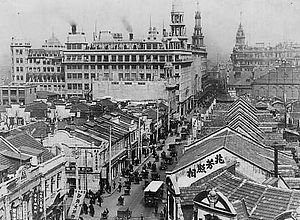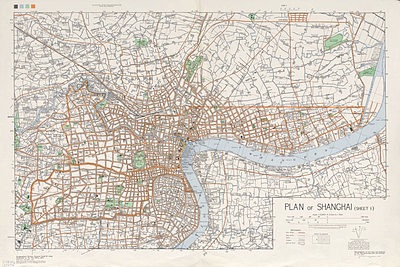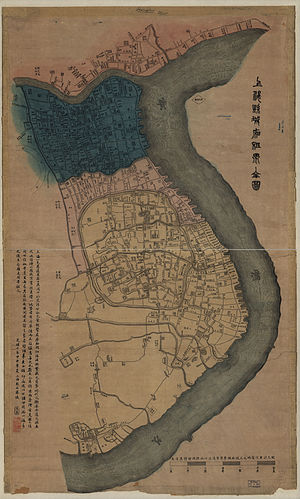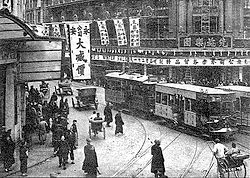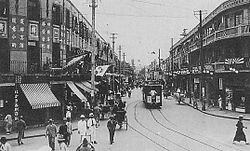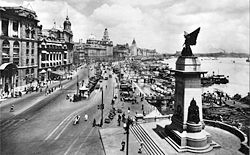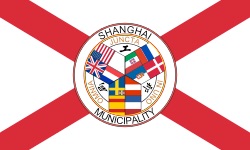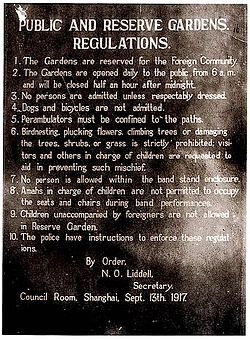Shanghai, China
Shanghai International Settlement
From Wikipedia, the free encyclopedia
Nanking Road, Shanghai, within the International Settlement.
1935 map of Shanghai.
The Shanghai International Settlement (Chinese: 上海公共租界; Japanese: 上海共同租界; French: Concession Internationale de Changhai; German: Internationale Konzession von Shanghai; Russian: Шанхайский международный сеттльмент; Italian: Insediamento Internazionale di Shanghai or Concessione Internazionale di Shanghai; Portuguese: Liquidação Internacional de Xangai: Dutch: Internationale Concessie van Shanghai; Spanish: Acuerdo internacional de Shangai) began originally as a purely British settlement. It was one of the original five treaty ports which were established under the terms of the Treaty of Nanking at the end of the first opium war in the year 1842.
American and French involvement followed close on the heels, and distinct areas of settlement for the Americans and the French were drawn out to the north and south of the British settlement respectively. In 1854 a united municipal council was created to serve all three settlements, but in 1862, the French concession dropped out of the arrangement. The following year the British and American settlements formally united to become the Shanghai International Settlement.
As more foreign powers entered into treaty relations with China, their nationals also became part of the administration of the settlement, but it always remained a predominantly British affair, at least until the late 1930s when Japan's involvement became of increasing importance. Unlike the colonies of Hong Kong and Weiheiwei which were sovereign British territories, the Shanghai International Settlement always remained Chinese sovereign territory. Hence when the British declared war against Germany in 1939, German nationals continued to operate freely within the territory of the international settlement.
The international settlement came to an abrupt end in December 1941 when Japanese troops stormed in immediately following the attack on Pearl Harbor. In early 1943, new treaties signed by Chiang Kai-shek's free Chinese government with Britain and British India on the one hand, and with the United States on the other hand, brought to an end the extraterritorial privileges which had been enjoyed by British subjects and American citizens for one hundred years.
History of the Shanghai International Settlement
Arrival of the British, Americans, and Europeans (19th Century)
1884 map of Shanghai with foreign concessions: the British Concession in blue, the French Concession to the south in faded red and American Concession to the north in faded orange; Chinese part of the city to the south of the French Concession in faded yellow.
While Europeans had already shown interest in Shanghai's strategic position as a port, the first settlement in Shanghai for foreigners was the British settlement which was opened in 1843 under the terms of the Treaty of Nanking following the first Anglo-Chinese Opium War. At first the Chinese governor of Shanghai refused to allow the British Consul, Captain Sir George Balfour, a place to hold consul. A pro-British Cantonese businessman offered his own home as a consul-building for the time being, with construction of a Western-style building within the official Settlement boundaries just to the south of the Soochow Creek completed within the year.
This soon became the epicenter of the British settlement. Afterward both the French and the Americans signed treaties with China which gave their citizens extraterritorial rights similar to those granted to the British, but initially their respective nationals accepted that the foreign settlement came under British consular jurisdiction.
The American treaty was signed in July 1844 by a Massachusetts politician, Caleb Cushing (1800–1879), who was dispatched with orders to "save the Chinese from the condition of being an exclusive monopoly in the hands of England" as a consequence of the Treaty of Nanjing. Cushing signed the treaty with the Imperial Chinese government at Wanghia, gaining Americans the same rights as those enjoyed by the British in China's treaty ports. It also contained a clause that effectively carved out Shanghai as an extraterritorial zone within Imperial China, though it did not actually give the American government a true legal concession.[1]
It was only in 1845 that Britain followed in America's footsteps and signed a land-deal to allow Britons to rent land in Shanghai in perpetuity. The American consular presence did not create a problem for the British because it was never intended to have a post in person. Since American traders in China were prohibited from engaging in the opium trade (though almost all were active in this trade), their business transactions were conducted under the auspices of British firms. The only serious incident of political complaint against the Americans was in 1845, when the Stars and Stripes was raised by the acting-US Consul, Henry G. Wolcott, who had just arrived in the city. Neither the British, nor the Chinese governor, approved of the display. In 1848, France established its own French concession under French consular jurisdiction, squeezed between the south of the British settlement and north of the Chinese walled city.
During the Taiping Rebellion, and with the Concessions effectively landlocked by both the Manchu government and Small Swords Society rebels, the Western residents of the Shanghai International Settlement, known as "Shanghailanders", refused to pay taxes to the Chinese government except for land and maritime rates (nominally because Shanghai's customs house had been burnt down). They also claimed the right to exclude Chinese troops from the concession areas. While the Settlement had at first disallowed non-foreigners to live inside its boundaries, a large number of Chinese were allowed to move into the International Settlement to escape the Taipings or seek better economic opportunities. Chinese entry was subsequently legalised and continued to grow.
The Municipal Council
Shanghai tram, British section, 1920s.
On 11 July 1854 a committee of Western businessmen met and held the first annual meeting of the Shanghai Municipal Council, ignoring protests of consular officials, and laid down the Land Regulations which established the principles of self-government. The aims of this first Council were simply to assist in the formation of roads, refuse collection, and taxation across the disparate Concessions.
In 1863 the American concession (land fronting the Huangpu River to the north-east of Suzhou Creek) officially joined the British Settlement (stretching from Yang-ching-pang Creek to Suzhou Creek) to become the Shanghai International Settlement. The French concession remained independent and the Chinese retained control over the original walled city and the area surrounding the foreign enclaves. This would later result in sometimes absurd administrative outcomes, such as needing three drivers' licenses to travel through the complete city.
By the late-1860s Shanghai's official governing body had been practically transferred from the individual concessions to the Shanghai Municipal Council (工部局, literally "Works Department", from the standard English local government title of 'Board of works'). The British Consul was the de jure authority in the Settlement, but he had no actual power unless the ratepayers (who voted for the Council) agreed. Instead, he and the other consulates deferred to the Council.
The International Settlement was wholly foreign-controlled, with staff of all nationalities, including British, Americans, Danes, and Germans. In reality, the British held the largest number of seats on the Council and headed all the Municipal departments (British included Australians, New Zealanders, Canadians, Newfoundlanders, and South Africans whose extraterritorial rights were established by the United Kingdom treaty). The only department not chaired by a Briton was the Municipal Orchestra, which was controlled by an Italian.
No Chinese residing in the International Settlement were permitted to join the council until 1928. Amongst the many members who served on the council, its chairman during the 1920s, Stirling Fessenden, is possibly the most notable. An American, he served as the settlement's main administrator during Shanghai's most turbulent era, and was considered more "British" than the council's British members. He oversaw many of the major incidents of the decade, including the May 30th Movement and the White Terror that came with the Shanghai massacre of 1927.
The International Settlement maintained its own fire-service, police force (the Shanghai Municipal Police), and even possessed its own military reserve in the Shanghai Volunteer Corps (萬國商團). Following some disturbances at the British concession in Hankow in 1927, the defences at Shanghai were augmented by a permanent battalion of the British Army, which was referred to as 'The Shanghai Defence Force' (SDF or SHAF),[2] and a contingent of US Marines. Other armed forces would arrive in Shanghai; the French Concession had a defensive force of Annamite troops, the Italians also introduced their own marines, as did the Japanese (whose troops eventually outnumbered the other countries' many times over).
By the mid-1880s, the Council had become a practical monopoly over the city's businesses. It bought up all the local gas-suppliers, electricity producers and water-companies, then — during the 20th-century — took control over all non-private rickshaws and the Settlement tramways. It also regulated opium sales and prostitution until their banning in 1918 and 1920 respectively.
Until the late-1920s, therefore, the SMC and its subsidiaries, including the police, power station, and public works, were British dominated (though not controlled, since Britain itself had no authority over the Council). Some of the Settlement's actions during this period, such as the May 30th Movement, in which Chinese demonstrators were shot by members of the Shanghai Municipal Police, did embarrass and threaten the British Empire's position in China even though they were not carried out by "Britain" itself.
In summary, the International Settlement was not a British possession in the sense that Hong Kong or Weihaiwei were, and was instead ruled as a self-governing treaty port under the terms of the Treaty of Nanking 1842. Chinese sovereignty still prevailed on the territory, but individuals who were not Chinese and were members of the Fourteen Favoured Nations (Belgium, Brazil, Denmark, France, Italy, Japan, The Netherlands, Norway, Portugal, Spain, Sweden, Switzerland, the United Kingdom and the United States) enjoyed extraterritoriality. The SMC did however exercise a considerable degree of political autonomy over both foreign and Chinese within its borders.
The rise of Imperial Japan (20th century)
In the 19th century, Europeans possessed treaty ports in Japan in the same way they held those in China. However, Japan rapidly developed into a modern nation, and by the turn of the 20th century the Japanese had successfully negotiated with all powers to abrogate all unequal treaties with it. Japan stood alongside the other European powers as part of the Eight-Nation Alliance during the famous fifty-five day siege of the foreign embassy compound in Peking. Japan entered the 20th century as a rising world power, and with its unequal treaties with the European powers now abrogated, it actually joined in, obtaining an unequal treaty with China granting extraterritorial rights under the Treaty of Shimonoseki signed in 1895.
In the year 1915, during the First World War, Japan overtook Britain as the country with the largest number of foreign residents in Shanghai. In 1916 they sided with Britain and France in the war and conquered all German possessions in China. By the beginning of the 1930s, Japan was swiftly becoming the most powerful national group in Shanghai and accounted for some 80% of all extraterritorial foreigners in China. Much of Hongkew, which had become an unofficial Japanese settlement, was known as Little Tokyo.
In 1931, supposed "protection of Japanese colonists from Chinese aggression" in Hongkou was used as a pretext for the Shanghai Incident, when Japanese troops invaded Shanghai. From then until the Second Sino-Japanese War (1937–1945) Hongkew was almost entirely outside of the SMC's hands, with law and protection enforced to varying degrees by the Japanese Consular Police and Japanese members of the Shanghai Municipal Police.
Japanese take over rest of Shanghai (1937)
Further information: Battle of Shanghai
Japanese soldiers in Shanghai, 1937.
In 1932 there were 1,040,780 Chinese living within the International Settlement, with another 400,000 fleeing into the area after the Second Sino-Japanese War broke out in 1937. For the next five years, the International Settlement and the French Concession were surrounded by Japanese occupiers and Chinese revolutionaries, with conflict often spilling into the Settlement's borders. In 1941, the Japanese launched an abortive political bid to take over the SMC: during a mass meeting of ratepayers at the Settlement Race Grounds, a Japanese official leaped up and shot William Keswick, then Chairman of the Council. While Keswick was only wounded, a near riot broke out.[3]
Japanese occupy the International Settlement (1941)
Anglo-American influence effectively ended after 8 December 1941, when the Imperial Japanese Army entered and occupied the British and American controlled parts of the city in the wake of the attack on Pearl Harbor. The French and Americans surrendered without a shot, while the only British riverboat in Shanghai, HMS Peterel, refused to surrender and was destroyed.
European Shanghai residents were forced to wear armbands to differentiate them, were evicted from their homes, and — just like Chinese citizens — were liable to maltreatment. All were liable for punitive punishments, torture and even death during the period of Japanese occupation. The Japanese sent European and American citizens to be interned at the Lunghua Civilian Assembly Center, a work camp on what was then the outskirts of Shanghai. Survivors of Lunghua were released at the end of 1945.
Amongst all this, Shanghai was notable for a long period as the only place in the world that unconditionally offered refuge for Jews escaping from the Nazis.[4] These refugees often lived in squalid conditions in an area known as the Shanghai ghetto in Hongkew. On 21 August 1941 the Japanese government closed Hongkew to Jewish immigration.
Return of the Settlement to Chinese Rule
In February 1943, the International Settlement was de jure returned to the Chinese as part of the British–Chinese Treaty for the Relinquishment of Extra-Territorial Rights in China and US China Treaty for Relinquishment of Extraterritorial Rights with the Nationalist Government of the Republic of China under Chiang Kai-shek. However, because Shanghai was under Japanese control, this was unenforceable. In reply, in July 1943, the Japanese retroceded the SMC to the City Government of Shanghai, which was then in the hands of the pro-Japanese Wang Jingwei Government.
Although the original treaty between Britain and China the Treaty of Nanking was signed in 1842 on behalf of the entire British Empire, the new treaty of 1943 was only signed on behalf of the United Kingdom, colonies and British India. It was not signed on behalf of the dominions. Canada signed its own treaty with China the following year.
After the war and the liberation of the city from the Japanese, a Liquidation Commission fitfully met to discuss the remaining details of the handover. By the end of 1945, most westerners not actively involved in the Chinese Civil War (such as intelligence agents, soldiers, journalists etc.) or in Shanghai's remaining foreign businesses, had left the city. With the defeat of the Kuomintang in 1949, the city was occupied by Communist troops and came under the control of Mayor of Shanghai.
The foreign architecture of the International Settlement era can still be seen today along the Bund and in many locations around the city.
Legal System in the Shanghai International Settlement
The Bund, 1928.
The International Settlement did not have a unified legal system. The Municipal Council issued Land Regulations and regulations under this, that were binding on all people in the settlement. Other than this, citizens and subjects of powers that had treaties with China that provided for extraterritorial rights were subject to the laws of their own countries and civil and criminal complaints against them were required to be brought against them to their consular courts (courts overseen by consular officials) under the laws of their own countries.
Treaty Powers included Britain, France, Germany, Austro-Hungary, Belgium and the United States. Japanese citizens also enjoyed extraterritorial rights under a reciprocal treaty signed in the 1870s and then under the Treaty of Shimonoseki signed in 1895. Chinese citizens and citizens of non-treaty powers, for example Portugal, and after World War I, Germany, were subject to Chinese law. Inside the Settlement, cases against them would be brought to the Mixed Court a court established in the Settlement in the 1870s which existed until 1927. In cases involving foreigners, a foreign assessor, usually a consular officer, would sit with the Chinese magistrate and in many cases acted like a judge.
Two countries, Britain and the United States established formal court systems in China to try cases. The British Supreme Court for China and Japan was established in 1865 and located in its own building in the British Consulate compound and the United States Court for China was established in the US Consulate in 1906. Both courts were occupied by the Japanese on 8 December 1941 and effectively ceased to function from that date.
Currency in the Shanghai International Settlement
The currency situation in China generally was very complicated in the 19th century. There was no unified system. Different parts of China operated different systems, and the Spanish pieces of eight that had been coming from Mexico for a few hundred years on Manila Galleons taken root along the China coast. Until the 1840s these silver dollar coins were Spanish coins minted mainly in Mexico City, but from the 1840s these gave way to Mexican republican dollars.
In Shanghai, this complexity represented a microcosm of the complicated economy existing elsewhere along the China coast. The Chinese reckoned in weights of silver, which did not necessarily correspond to circulating coins. One major weight was a tael, which came in a variety of types depending on the amount of silver they equalled. These included: Customs Taels (for foreign trade), Cotton Taels (for cotton trade), etc. Shanghai had its own tael, which was very similar in weight to the Customs Tael and therefore popular for international business. China also had a mixture of coins, including Chinese Copper Cash coins and Mexican dollars. Paper money was first issued by European and North American colonial banks (one British colonial bank known as the Chartered Bank of India, Australia, and China at one time issued banknotes in Shanghai that were denominated in Mexican dollars).
European and North American currencies did not officially circulate in the International Settlement, except Yen in the Japanese district of "Little Tokyo". Until the year 1873, however, US dollar coins would have reasonably corresponded in size, shape and value to Mexican dollars. Between 1873 and 1900, all silver standard dollars had depreciated to about 50% of the value of the gold standard dollars of the USA and Canada leading to a rising economic depression.
The Chinese themselves officially adopted the dollar unit as their national currency in 1889, and the first Chinese dollar coins, known as yuan, contained an inscription which related their value to an already existing Chinese system of accounts. On the earliest Chinese dollar (yuan) coins it states the words 7 mace and 2 candareens. The mace and candareen were sub-divisions of the tael unit of weight.[5] Banknotes tended to be issued in dollars, either worded as such or as yuan.
Despite the complications arising from a mixture of Chinese and Spanish coinages, there was one overwhelming unifying factor binding all the systems in use: silver. The Chinese reckoned purely in terms of silver, and value was always compared against a weight of silver (hence, the reason large prices were given in tael). It was the strict adherence of the Chinese to silver that caused China and even the British colonies of Hong Kong and Weihaiwei to remain on the silver standard after the rest of the world had changed over to the gold standard. When China officially began producing official Republican yuan coins in 1934, they were minted in Shanghai and shipped to Nanking for distribution.
Postal services in the International Settlement
The flag of the Shanghai International Settlement.
Shanghai had developed a postal service as early as the Ming Dynasty, but during the treaty port era foreign postal services were organized through their respective consulates. For example, the United States Post Office Department maintained a United States Postal Agency at the Shanghai consulate through which Americans could use the U.S. Post Office to send mail to and from the U.S. mainland and U.S. territories. Starting in 1919 the 16 current regular U.S. stamps were overprinted for use in Shanghai with the city's name, "China", and amounts double their printed face values.[6] In 1922 texts for two of the overprints were changed, thereby completing the Scott catalog set of K1-18, "Offices in China".
The British originally used British postage stamps overprinted with the local currency amount, but from 1868, the British changed to Hong Kong postage stamps already denominated in dollars. However, in the special case of Shanghai, in the year 1865 the International settlement began to issue its own postage stamps, denominated in the local Shanghai tael unit.
The Shanghai Post Office controlled all post within the Settlement, but post coming in or going out of the treaty port was required to go through the Chinese Imperial Post Office. In 1922 the various foreign postal services, the Shanghai Post Office and the Chinese Post Office were all brought together into a single Chinese Post Office, thus extending the 1914 membership of the Chinese Post Office to the Universal Postal Union to Shanghai Post Office. Some other foreign countries refused to fall under this new postal service's remit, however: for many years, Japan was notable as sending almost all its mail to Shanghai in diplomatic bags, which could not be opened by postal staff.
The General Shanghai Post Office was first located on Beijing Road and moved to the location on Sichuan North Road of the General Post Office Building, Shanghai that is today the Shanghai Post Museum.
List of Chairmen of the Shanghai Municipal Council
"The Gardens (Huangpu Park) are reserved for the Foreign Community".
Some of the persons who chaired the Shanghai Municipal Council were:[7]
-
•Frederick Anderson (1905/1906)
-
•William Keswick (1865/66)
-
•Henry Keswick—British Quarter
-
•Harry Edward Arnhold (born 16 January 1879 in London)
-
•
Notable people born in the International Settlement
-
•J.G. Ballard, writer
-
•Mary Hayley Bell, actress
-
•
French Concession
The French Concession was governed by a separate municipal council, under the direction of the Consul General. The French Concession was not part of the International Settlement.
See also[
-
•Tilanqiao Prison (formerly Ward Road Gaol)
-
•
Notes
-
1.^ Sergeant, H. Shanghai (1998) at pp 16–17.
-
4.^ Wasserstein, B. Secret War in Shanghai (1999) at pp 140–150.
-
7.^ For complete list, see "Foreign Concessions and Colonies: Shanghai International Settlement"; http://www.worldstatesmen.org/China_Foreign_colonies.html#Shanghai-International
Further reading
-
•"Tales of Old Shanghai", Earnshaw Books
-
•Bickers, Robert, "Empire Made Me: An Englishman Adrift in Shanghai", Allen Lane History.
-
•Hann, J.H. "Origin and Development of the Political System in the Shanghai International Settlement", Journal of the Hong Kong Branch of the Royal Asiatic Society 22 (1982):31–64.
-
•Hann, J.H. "The Shanghai Municipal Council, 1850–1865: Some Biographical Notes, Journal of the Hong Kong Branch of the Royal Asiatic Society 24 (1984):207–229.
-
•Bergere, Marie-Claire: Shanghai: China's Gateway to Modernity. Transl. from French by Janet Lloyd. Stanford: Stanford University Press, 2010. ISBN 978-0-8047-4905-3.


